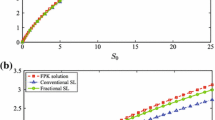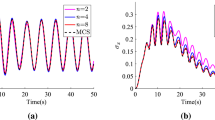Abstract
Moment equation method is commonly used in the analysis of nonlinear stochastic systems. However, in some cases, this method may lead to poor accuracy, or even invalid results, because only limited number of moments of the response is available. In order to overcome this limitation, this paper develops a new fractional moment equation methodology. The new method involves the derivation of fractional moment equation of nonlinear systems and the approximation of probability density function (PDF) of response by means of a novel fractional moment closure scheme. Benefitting from the valuable features of fractional moments, i.e., few number of fractional moments contain large amount of statistical information about the variable, the developed method achieves more accurate PDF estimation of the response when compared with the present methods, especially for nonlinear systems with multiple equilibria. The effectiveness of the new method is finally demonstrated by a Duffing and a bistable Duffing oscillator that is subjected to Gaussian white noise. The results are compared with the Gaussian closure approximation and exact solution.




Similar content being viewed by others
Abbreviations
- c :
-
The normalization coefficient of PDFs
- \(E{[}\cdot {]}\) :
-
The expectation operator
- \(f( \cdot )\) :
-
The probabilistic density function (PDF)
- \(f( { \cdot , \cdot } )\) :
-
The joint density function
- \(F\left( t \right) \) :
-
The Gaussian white noise with zero mean
- \({\hat{f}}( \cdot )\) :
-
The estimated PDF
- \({\hat{f}}( { \cdot , \cdot })\) :
-
The estimated joint density function
- g(x):
-
The nonlinear restoring force
- h(t):
-
A continuous function
- m :
-
The total number of \(\lambda _{i}\) or \(\alpha _i\) in the estimated PDF
- M :
-
A positive integer
- m(t):
-
A continuous function
- n :
-
Number of fractional moment equations used in \(\varGamma ( {{p_j},{\lambda _i},{\alpha _i}})\)
- p(t):
-
A continuous function
- \({S_0}\) :
-
The spectral density of F(t)
- v(x):
-
Mean up-crossing rate
- x(t):
-
The response of displacement
- \({\dot{x}} (t)\) :
-
The response of velocity
- \(\alpha _i\) :
-
The parameter in estimated PDF
- \(\beta \) :
-
Damping coefficient
- \(\varGamma ( {{p_j},{\lambda _i},{\alpha _i}})\) :
-
The cost function of fractional moment closure scheme
- \(\varepsilon \) :
-
The nonlinear intensity of nonlinear systems
- \(\eta {[} {{f_X}( x)} {]}\) :
-
The entropy of a continuous random variable X
- \(\lambda ( x )\) :
-
An arbitrary differentiable function
- \(\lambda _{i}\) :
-
The parameter in estimated PDF
- \(\tau \) :
-
Time lag of stationary response
- \({1_\mathrm{event}}\) :
-
Indicator function, it equals to 1 if event is true and 0 otherwise
- \(\mathbb {N}\) :
-
The set of integer
- \(\mathbb {R}\) :
-
The set of real number
References
Crandall, S.H.: A half-century of stochastic equivalent linearization. Struct. Control Health Monit. 13(1), 27–40 (2006)
Roberts, J.B., Spanos, P.D.: Random Vibration and Statistical Linearization. Courier Corporation, Chelmsford (2003)
Dai, H., Zheng, Z., Ma, H.: An explicit method for simulating non-gaussian and non-stationary stochastic processes by karhunen-loeve and polynomial chaos expansion. Mech. Syst. Signal Process. 115, 1–13 (2019)
Qiu, J., Sun, K., Wang, T., Gao, H.: Observer-based fuzzy adaptive event-triggered control for pure-feedback nonlinear systems with prescribed performance. IEEE Trans. Fuzzy Syst. https://doi.org/10.1109/TFUZZ.2019.2895560.
Sun, K., Mou, S., Qiu, J., Wang, T., Gao, H.: Adaptive fuzzy control for non-triangular structural stochastic switched nonlinear systems with full state constraints. IEEE Trans. Fuzzy Syst. https://doi.org/10.1109/TFUZZ.2018.2883374.
Chen, J., Rui, Z.: Dimension-reduced FPK equation for additive white-noise excited nonlinear structures. Probab. Eng. Mech. 53, 1–13 (2018)
Li, J., Chen, J.: Stochastic Dynamics of Structures. Wiley, Hoboken (2009)
Socha, L.: Linearization in analysis of nonlinear stochastic systems: recent results-part i: theory. Appl. Mech. Rev. 58(3), 178–205 (2005)
Elishakoff, I.: Stochastic linearization technique: a new interpretation and a selective review. Shock Vib. Dig. 32(3), 179–188 (2000)
Noori, M., Davoodi, H.: Comparison between equivalent linearization and gaussian closure for random vibration analysis of several nonlinear systems. Int. J. Eng. Sci. 28(9), 897–905 (1990)
Wu, W.-F.: Comparison of gaussian closure technique and equivalent linearization method. Probab. Eng. Mech. 2(1), 2–8 (1987)
Ricciardi, G., Elishakoff, I.: A novel local stochastic linearization method via two extremum entropy principles. Int. J. Non-linear Mech. 37(4), 785–800 (2002)
Er, G.-K.: An improved closure method for analysis of nonlinear stochastic systems. Nonlinear Dyn. 17(3), 285–297 (1998)
Er, G.-K.: Crossing rate analysis with a non-gaussian closure method for nonlinear stochastic systems. Nonlinear Dyn. 14(3), 279–291 (1997)
Crandall, S.H.: Non-gaussian closure for random vibration of non-linear oscillators. Int. J. Non-linear Mech. 15(4), 303–313 (1980)
Joo, H.K., Sapsis, T.P.: A moment-equation-copula-closure method for nonlinear vibrational systems subjected to correlated noise. Probab. Eng. Mech. 46, 120–132 (2016)
Makarem, H., Pishkenari, H.N., Vossoughi, G.R.: A modified gaussian moment closure method for nonlinear stochastic differential equations. Nonlinear Dyn. 89(4), 2609–2620 (2017)
Xiao, Y., Xu, W., Yang, Y.: Response of strongly nonlinear vibro-impact system with fractional derivative damping under gaussian white noise excitation. Nonlinear Dyn. 85(3), 1955–1964 (2016)
Di Paola, M.: Fokker planck equation solved in terms of complex fractional moments. Probab. Eng. Mech. 38, 70–76 (2014)
Yang, Y., Xu, W., Jia, W., Han, Q.: Stationary response of nonlinear system with caputo-type fractional derivative damping under gaussian white noise excitation. Nonlinear Dyn. 79(1), 139–146 (2015)
Rossikhin, Y.A., Shitikova, M.V.: Application of fractional calculus for dynamic problems of solid mechanics: novel trends and recent results. Appl. Mech. Rev. 63(1), 010801-1–010801-52
Dai, H., Zheng, Z., Wang, W.: A new fractional wavelet transform. Commun. Nonlinear Sci. Numer. Simul. 44, 19–36 (2017)
Zheng, Z., Zhao, W., Dai, H.: A new definition of fractional derivative. Int. J. Non-linear Mech. 108, 1–6 (2019)
Dai, H., Zheng, Z., Wang, W.: On generalized fractional vibration equation. Chaos Solitons Fractals 95, 48–51 (2017)
Dai, H., Zheng, Z., Wang, W.: Nonlinear system stochastic response determination via fractional equivalent linearization and Karhunen–Loeve expansion. Commun. Nonlinear Sci. Numer. Simul. 49, 145–158 (2017)
Zheng, Z., Dai, H.: A new fractional equivalent linearization method for nonlinear stochastic dynamic analysis. Nonlinear Dyn. 91(2), 1075–1084 (2018)
Dai, H., Ma, Z., Li, L.: An improved complex fractional moment-based approach for the probabilistic characterization of random variables. Probab. Eng. Mech. 53, 52–58 (2018)
Cottone, G., Di Paola, M., Metzler, R.: Fractional calculus approach to the statistical characterization of random variables and vectors. Phys. A Stat. Mech. Its Appl. 389(5), 909–920 (2010)
Inverardi, P Novi, Petri, A., Pontuale, G., Tagliani, A.: Stieltjes moment problem via fractional moments. Appl. Math. Comput. 166(3), 664–677 (2005)
Xu, J., Kong, F.: Adaptive scaled unscented transformation for highly efficient structural reliability analysis by maximum entropy method. Struct. Saf. 76, 123–134 (2019)
Xu, J., Wang, D., Dang, C.: A marginal fractional moments based strategy for points selection in seismic response analysis of nonlinear structures with uncertain parameters. J. Sound Vib. 387, 226–238 (2017)
Xu, J., Zhu, S.: An efficient approach for high-dimensional structural reliability analysis. Mech. Syst. Signal Process. 122, 152–170 (2019)
Zhang, X., He, W., Zhang, Y., Pandey, M.D.: An effective approach for probabilistic lifetime modelling based on the principle of maximum entropy with fractional moments. Appl. Math. Model. 51, 626–642 (2017)
Zhang, X., Pandey, M.D.: Structural reliability analysis based on the concepts of entropy, fractional moment and dimensional reduction method. Struct. Saf. 43, 28–40 (2013)
Tagliani, A.: Maximum entropy density estimation from fractional moments Novi Inverardi PL. Commun. Stat. Theor. Methods 32(2), 327–345 (2003)
Dai, H., Zhang, H., Wang, W.: A new maximum entropy-based importance sampling for reliability analysis. Struct. Saf. 63, 71–80 (2016)
Stone, M.H.: The generalized weierstrass approximation theorem. Math. Mag. 21(5), 237–254 (1948)
Pradlwarter, H., Schueller, G.: Excursion probabilities of non-linear systems. Int. J. Non-linear Mech. 39(9), 1447–1452 (2004)
He, J., Zhao, Y.-G.: First passage times of stationary non-gaussian structural responses. Comput. Struct. 85(7), 431–436 (2007)
Acknowledgements
This research was supported by Grant from the National Natural Science Foundation of China (Project 11672091). This support is gratefully acknowledged.
Author information
Authors and Affiliations
Corresponding author
Ethics declarations
Conflict of interest
The authors declare that they have no conflict of interest concerning the publication of this manuscript.
Additional information
Publisher's Note
Springer Nature remains neutral with regard to jurisdictional claims in published maps and institutional affiliations.
Rights and permissions
About this article
Cite this article
Dai, H., Zhang, R. & Zhang, H. A new fractional moment equation method for the response prediction of nonlinear stochastic systems. Nonlinear Dyn 97, 2219–2230 (2019). https://doi.org/10.1007/s11071-019-05119-x
Received:
Accepted:
Published:
Issue Date:
DOI: https://doi.org/10.1007/s11071-019-05119-x




